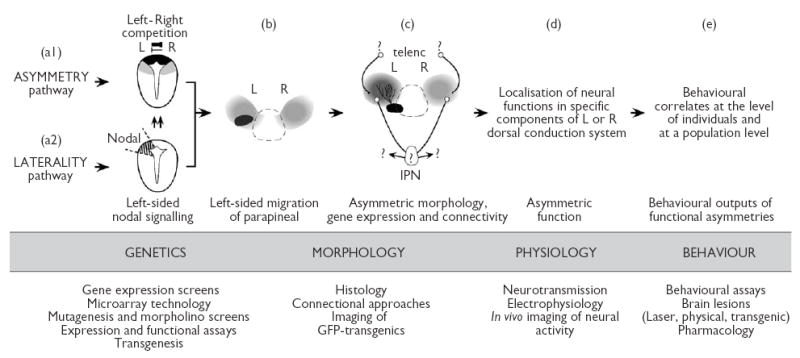Fig. 2.

A bottom up approach for the study of asymmetry/lateralisation/laterality in the dorsal diencephalic conduction system of zebrafish. The four basic levels of brain asymmetry/lateralisation/laterality are indicated in capitals. (Top) Summary of the current understanding of each level of asymmetry/lateralisation/laterality in zebrafish. (a1) Genetic control of asymmetry. Transversal view of the epithalamic region of the neural tube at day one of development showing the location of parapineal (black) and habenular (grey) precursors. Competitive interactions between left and right sides of the brain contribute to the initial establishment of CNS asymmetry [13]. (a2) Genetic control of laterality. Transverse view of the epithalamic region of the neural tube at day one of development showing left sided expression of Nodal genes. The role of Nodal signalling is to bias the outcome of left/right competition towards the left side of the brain [13,14]. (b,c) Dorsal views of the epithalamus at 2 (b) and 4 (c) days of development. (b) Morphological asymmetry of the parapineal organ is characterised by left-sided migration and by the development of asymmetric connectivity directed to the left habenula [13–15]. (c) Structural asymmetries of the habenular complex involve differential growth, development of neuropil, strength of gene expression and patterns of connectivity between the left and right sides [13–15]. Details of the subnuclear organisation and connectivity of various components of the dorsal diencephalic conduction system are still unknown (question marks). IPN (interpeduncular nuclei), telenc (telencephalon). Asymmetric morphology may determine the localisation of neural functions in specific components of the system and on a specific side of the brain (d). Lateralisation of neural functions may in turn have behavioural correlates at both individual and population levels (e). (Bottom) Experimental approaches currently available for the study of CNS asymmetry in zebrafish.
